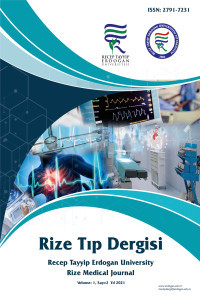Hippocrat Andı ve Nöroşirurji
AMAÇ: Hipokrat yemininin profesyonellik ve çağdaş tıp ve beyin cerrahisi olarak yeniden değerlendirilmesi çok önemli bir konu gibi görünüyor. Bu makalenin amacı, Hipokrat Yemini'ndeki “Önce zarar verme ya da primum nihil nocere terme” maddesini yeniden ele almak ve bu yeminin beyin cerrahisi yönünü araştırmaktır.
GEREÇ VE YÖNTEMLER: Nöroşirürji prosedürlerinde komplikasyonları değerlendiren çalışmaları belirlemek için bir PubMed araştırması yapıldı. Sorguda "komplikasyon", "nöroşirürji", "omurga cerrahisi", "kraniyotomi" ve "nörolojik cerrahi" terimleri kullanıldı. Daha sonra sonuçlar analiz edildi.
BULGULAR: Hasta güvenliği" ve "nöroşirürji uygulamalarındaki hatalar" toplum nezdinde giderek önem kazanan konulardır.
SONUÇ: Nöroşirürji pratiğinde genel olarak elverişsiz akışlarla birlikte beyin cerrahisinin yeniden icadı. Beyin cerrahisi pratiğindeki teknolojik ilerleme, beyin cerrahları ve hastalar için muazzam zorluklar yaratmıştır. Nöroşirürji pratiğinde Primum Nihil Nocere “ Önce zarar verme”terimi takip edilmelidir.
Anahtar Kelimeler:
Hippocratik oath, medicine, neurosurgery
Hippocratic Oath and the Contemporary Neurosurgical Practice
OBJECTIVE: A reassessment of the Hippocratic oath as professionalism and contemporary medicine and neurosurgery seems to be crucial subject. The purpose of this article is to revisit the “First, do no harm or primum nihil nocere terme of the Hippocratic Oath, and investigate the neurosurgical aspect of this oath.
MATERIAL AND METHODS: We performed a PubMed search to identify studies that evaluated the complication in neurosurgical procedures. The terms “comlication,” “neurosurgery,” “spine surgery,” “craniotomy,” and “neurological surgery” were all used in the query. We then analyzed the results.
RESULTS: Patient safety" and "errors in neurosurgical practice" are issues gaining more and more prominence in the eyes of the public.
CONCLUSION: The reinvention of neurosurgery coupled with generally unfavorable fluxes in the neurosurgical practice. Technological advancement in neurosurgical practice has created enormous challenges for neurosurgeons and patients. The term of Primum Nihil Nocere has to be followed in neurosurgical practice.
Keywords:
Hippocratic oath, Neurourgery, Medicine,
___
- 1. Isaacs D. The hippocratic oath. Vol. 47, Journal of paediatrics and child health. Australia; 2011. p. 321.
- 2. Sioutis S, Reppas L, Bekos A, Limneos P, Saranteas T, Mavrogenis AF. The Hippocratic Oath: Analysis and Contemporary Meaning. Orthopedics. 2021;44(5):264–72.
- 3. Kanat A, Epstein CR. Challenges to neurosurgical professionalism. Clin Neurol Neurosurg. 2010;112(10).
- 4. Gasenzer ER, Kanat A, Ozdemir V, Rakici SY, Neugebauer E. Interesting different survival status of musicians with malignant cerebral tumors. Br J Neurosurg. 2020 Jun;34(3):264–70.
- 5. Gasenzer ER, Kanat A, Ozdemir V, Neugebauer E. Analyzing of dark past and bright present of neurosurgical history with a picture of musicians. British Journal of Neurosurgery. 2018 May;303–4.
- 6. Kanat A. Wrong-site craniotomy. Journal of Neurosurgery United States; Oct, 2013 p. 1079–80.
- 7. Finkel MA, Adams JG. Professionalism in emergency medicine. Emerg Med Clin North Am. 1999 May;17(2):443–50.
- 8. Singhal S. Do No Harm: The Hippocratic Oath. Natl Med J India. 2019;32(6):375. 9. Al-Khori NA, Gunderman RB. The Hippocratic Oath: A Radiologic Perspective. AJR Am J Roentgenol. 2020 Oct;215(4):1039–41.
- 10. Fischerová S, Pohl M. Hippocratic Oath and current medical oaths. Cas Lek Cesk. 2022;161(5):212–9.
- 11. Mannell K, Fordyce R, Jethani S. Oaths and the ethics of automated data: limits to porting the Hippocratic oath from medicine to data science. Cult Stud.
- 12. Antoniou SA, Antoniou GA, Granderath FA, Mavroforou A, Giannoukas AD, Antoniou AI. Reflections of the Hippocratic Oath in Modern Medicine. WORLD J Surg. 2010;34(12):3075–9.
- 13. Fugate JE. Complications of Neurosurgery. Continuum (Minneap Minn). 2015 Oct;21(5 Neurocritical Care):1425–44.
- 14. Sarwal A. Neurologic Complications in the Postoperative Neurosurgery Patient. Continuum (Minneap Minn). 2021 Oct;27(5):1382–404.
- Başlangıç: 2020
- Yayıncı: Recep Tayyip Erdoğan Üniversitesi
Sayıdaki Diğer Makaleler
22 yaşında erişkin yaşta teşhis edilen bronşektazili pulmoner hipoplaz
Epidermolizis Bülloza ve Pylor Atrezisi
Şenol ŞENTÜRK, Gülşah BALIK, Figen KIR ŞAHİN, Mehmet KAĞITÇI
Bir çift monozigotik ikizde kopya efektli miyopik anizometropi: Bir Olgu Sunumu
HİPOPOTASEMİ İLE GELEN PANKREAS KANSERİNE BAĞLI EKTOPİK ACTH SENDROMU: VAKA SUNUMU
Hatice BEYAZAL POLAT, Teslime AYAZ, Damla TÜFEKÇİ, Osman CÜRE, Kadir İLKKILIÇ, Uğur AVCI, Bayram KIZILKAYA
Ayhan KANAT, Bülent ÖZDEMİR, Vacide AŞIK ÖZDEMİR, Elena ROMANA GASENZER
